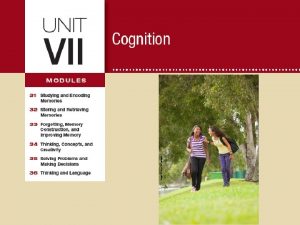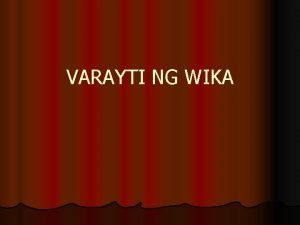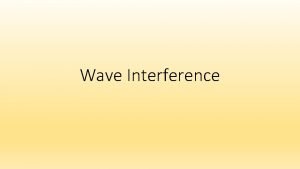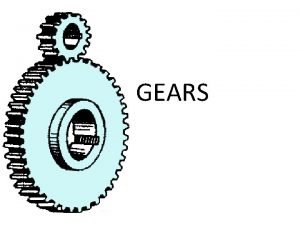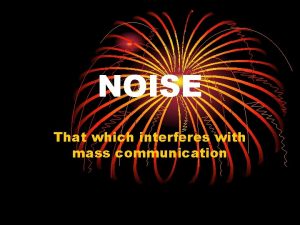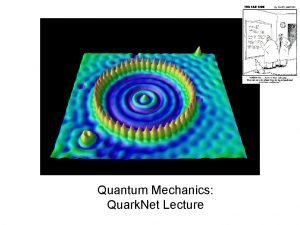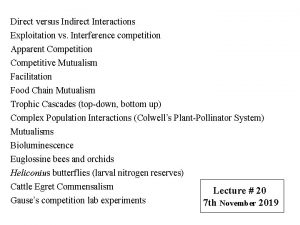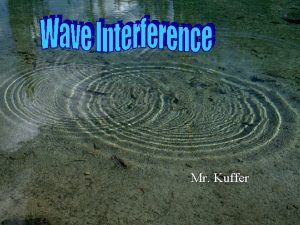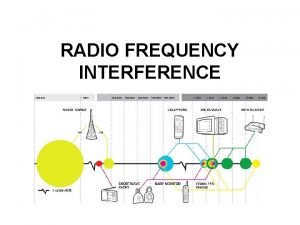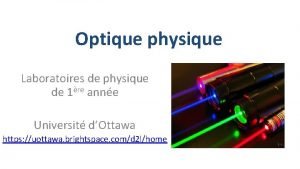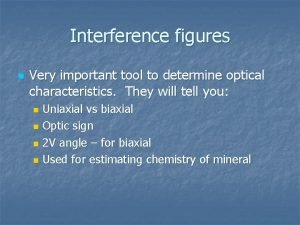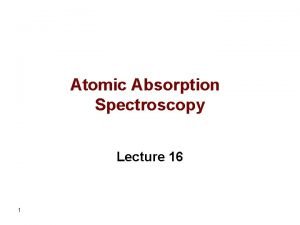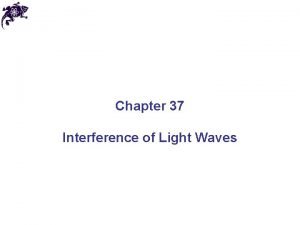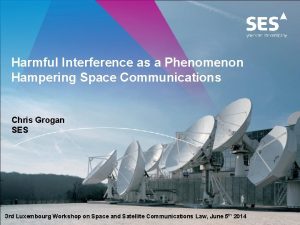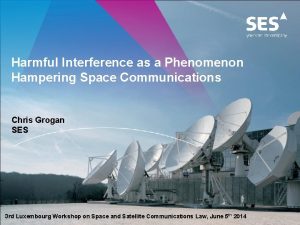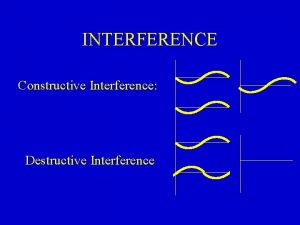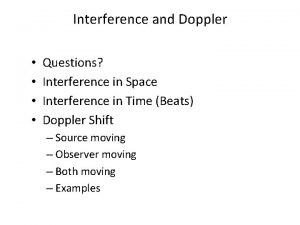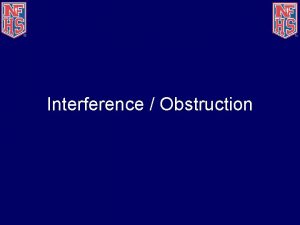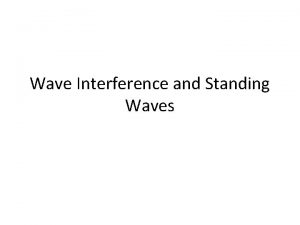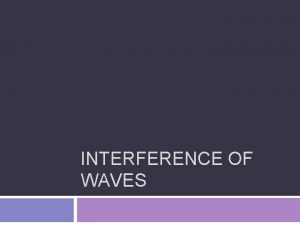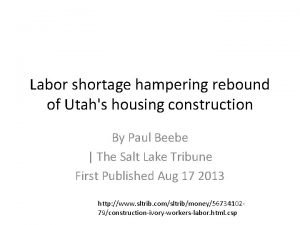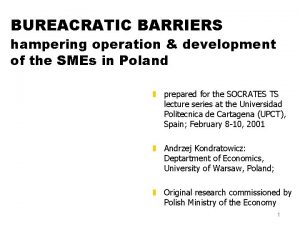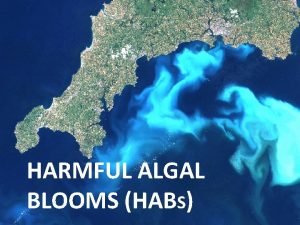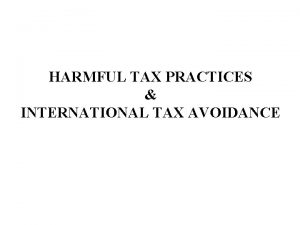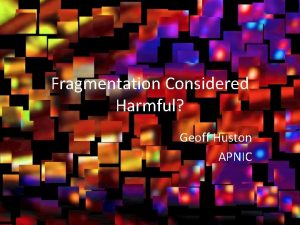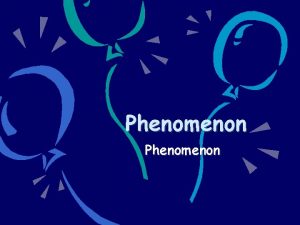Harmful Interference as a Phenomenon Hampering Space Communications




















- Slides: 20

Harmful Interference as a Phenomenon Hampering Space Communications Chris Grogan SES 3 rd Luxembourg Workshop on Space and Satellite Communications Law, June 5 th 2014

Interference Growth: The Perfect Storm SES Proprietary and Confidential

Business Growth: Good for Industry SES Proprietary and Confidential

Protecting the Environment SES Proprietary and Confidential

SES Perspective On Interference The Good News! Small amount of total capacity affected by RFI At any time, only a small amount of capacity is subject to interference Vast majority of fleet capacity provides high quality service, unaffected by interference, allowing SES’ customer’s to enjoy unrivalled availability and Qo. S. • Affected customer may have been restored, so no service impact • Some causes minor service degradation • Some may be causing full outage Preventitive Measures - Although a very small percentage of our capacity is affected, SES and other operators recognise that this can lead to significant problems for customer services and the Qo. S offered - SES invests significantly in order to mitigate any potential service impact. - Robust processes and procedures to maintain system and service integrity - Experienced staff available 24 x 7 to support customers and investigate interference - Infrastructure, monitoring/geolocation systems, and software tools to detect, analyze and resolve interference events 5

SES Payload Operations Facilities 30 CSM and 11 Geolocation facilities (owned and contracted) CSM Network provides remote RF spectrum monitoring of all SES beams SES Communications Systems Monitoring (CSM) Facility – remote spectrum monitoring; All with DSP SES Geolocation Capability; fixed sites (also have transportable/fly-away units) Additional analysis capability with DSP (signal analysis, carrier under carrier, constellation) Contracted Geolocation services 6

SES Interference Data (Global) Adjacent Satellite SES Satellite Co-Pol 31% wanted transmission Cross-Pol 38% unwanted ASI 7

Industry Collaboration SES Leadership of Industry Bodies who are working on RFI initiatives: Global VSAT Forum: Founding Board Member Si. RG (SUIRG): Founding Member & Director Space Data Association: Founding Executive Member Operators Interference Initiatives: Leading Participant We have active involvement with other industry bodies: RFI End User’s Initiative (Broadcast Customers) World Broadcast Union Int’l Satellite Users Group (WBU-ISOG)

3 rd Luxembourg Workshop on Space and Satellite Communications Law 5 th June, 2014 www. space-data. org This Briefing is Proprietary to the Space Data Association Limited and is NOT approved for public release

Contents § § SDA and the ‘Safety of Flight’ SDA Charter SDA Membership Where we are; Where we can go SDA Proprietary 10 10

What is the Space Data Association? § The Space Data Association (SDA) is a not-for-profit association formed by and for satellite operators to provide reliable and efficient data-sharing critical to the safety and integrity of the space environment and the RF spectrum and to improve the ‘Safety of Flight’ § The SDA was founded by Inmarsat, Intelsat and SES — three of the leading global satellite communications companies. These three companies, plus Eutelsat, now form the Executive Board of the SDA. “Safety of Flight” Definition: The condition where satellites are positioned and operated in a manner that preserves their long-term operational viability and the preservation of the orbital regime(s) involved SDA Proprietary 11 11

SDA Charter § Seek and facilitate improvements in the safety and integrity of satellite operations through wider and improved coordination between satellite operators § Seek and facilitate improved management of the shared resources of the Space Environment and the RF Spectrum Use or disclosure of data contained on this page is subject to the restriction on the title page of this document 12 12

Space Data Association Membership § Executive Directors – Eutelsat (Mark Rawlins), Inmarsat (John Mackey), Intelsat (Ron Busch) and SES (Chris Grogan) § Standard Member Director – Astrium (Philip Wadey) – Star. One (Erika Antonio De Souza Rossetto) § Including FOC participants – 241 GEO satellites from 18 operators – 118 LEO/MEO satellites from 7 operators – Approx. 57% of GEO satellites processed in SDC through operator data Use or disclosure of data contained on this page is subject to the restriction on the title page of this document 13 13

Space Data Association Overview SDA Executive Members: Chief Technology Adviser / SDC Operator: § Space Data Center § Verified, normalized data § Fully automated analysis/reporting § Open to all satellite operators in all orbital regimes § Growing participation § Strong legal agreements protect participant information from disclosure / misuse SDA Proprietary 14 14

SDA Current Participants Multi-national, open to all space operators, in all orbital regimes § 24 contributing operators § 3 civil satellite operators Use or disclosure of data contained on this page is subject to the restriction on the title page of this document 15 15

Where we are. Where we can go. § The Space Data Association (SDA) has successfully implemented an operational data sharing environment to support Conjunction Assessment (CA) processing and other technical operation functions, coupled with appropriate legal protection for participants. § The technical system, membership structure and legal framework lend themselves to additional uses which will support improved ‘Safety of Flight’. § The SDA offers a working platform for coordinating SSA, RFI and other data between users of the space environment. The SDA has a proven operational capability SDA Proprietary 16 16

Space Data Association Operations Statistics SDC FOC Statistics to Date (March 2013) § § Ephemerides files uploaded by members: 250, 865 CA runs executed: 6, 993 Pairs of satellites processed for CA: 18, 132, 248, 388 (18 B!) Conjunctions detected (50 km threshold): 4, 286, 915 – Equates to approx. 2. 6 million conjunctions for all GEO active satellites per year based on 50 km threshold – Growing confidence in predicts will allow smaller thresholds to be used > less conjunctions requiring action § TLE’s in database: 24, 906, 602 § Satellites in database: 16, 382 of which 325 are SDA participants and remainder are non-SDA active or debris SDA Proprietary 17 17

SDA Missions § Increases safety of flight – Automatic Conjunction Assessment (CA) – Reduces false alarms, missed events – Minimize time and resources devoted to CA – Includes planned manoeuvres (unique capability) § Deals with the growing problem of RFI – RFI Alerts to focused distribution – RFI historical event search: data support – Generation of geolocation data sets – Library of Carrier ID data and Reference Emitters § Enables more efficient operations for all – Reliable contacts database for satellite operators – technical and operations personnel SDA Proprietary Conclusion: SDA Enhances its Members’ Satellite Operations 18 18

SDA Supports Collaborative Improvements in Satellite Operations § Dissemination of ‘best practices’ – SDA legal agreements enforce appropriate behaviour – Validation of participant’s data and processes § Enhanced Conjunction Analysis (CA) – Merging/processing SDA owner-operator data and other sources SDA Proprietary 19 19

Thank You ! May 2014 20
 Proactive interference vs retroactive interference
Proactive interference vs retroactive interference Retroactive vs reactive
Retroactive vs reactive Ano ang teoryang sosyolinggwistiko
Ano ang teoryang sosyolinggwistiko Example of harmful materials and harmful materials
Example of harmful materials and harmful materials Joint space vs cartesian space
Joint space vs cartesian space World space to screen space
World space to screen space Space junk the space age began
Space junk the space age began Camera space to world space
Camera space to world space Cartesian space vs joint space
Cartesian space vs joint space Mechanical wave interference
Mechanical wave interference Interference in gears
Interference in gears Interference competition
Interference competition Interference in mass communication
Interference in mass communication Interference pattern
Interference pattern Interference competition
Interference competition Draw the interference pattern for the two waves
Draw the interference pattern for the two waves Interference of radio waves
Interference of radio waves Patron d'interférence
Patron d'interférence Melatope
Melatope Interference of atomic absorption spectroscopy
Interference of atomic absorption spectroscopy Constructive interference formula
Constructive interference formula
